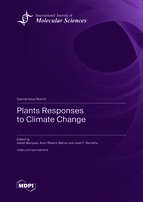Plants Responses to Climate Change
A special issue of International Journal of Molecular Sciences (ISSN 1422-0067). This special issue belongs to the section "Molecular Plant Sciences".
Deadline for manuscript submissions: closed (30 June 2023) | Viewed by 27774
Special Issue Editors
Interests: evolution; agro-forestry; biomarkers; genomics; ecosystem services
Special Issues, Collections and Topics in MDPI journals
Interests: plant–environment interactions; biodiversity
Special Issues, Collections and Topics in MDPI journals
Interests: coffee
Special Issues, Collections and Topics in MDPI journals
Special Issue Information
Dear Colleagues,
Climate change is expected to have a wide range of impacts on plant physiology and metabolism, soil fertility and carbon sequestration, and microbial diversity and activity. This imposes direct limitations on plant growth, fertility, and productivity. To promote the sustainability of ecosystems, efforts are necessary to enhance our knowledge of molecules governing key processes that might play a role in the mechanisms of stress resilience in plants.
This Special Issue aims to publish a collection of studies that use integrated molecular tools to unveil plant responses to environmental stresses associated with climate change. Authors are invited to submit related original research articles, reviews, and communications.
Dr. Isabel Marques
Prof. Dr. Ana I Ribeiro-Barros
Dr. José C. Ramalho
Guest Editors
Manuscript Submission Information
Manuscripts should be submitted online at www.mdpi.com by registering and logging in to this website. Once you are registered, click here to go to the submission form. Manuscripts can be submitted until the deadline. All submissions that pass pre-check are peer-reviewed. Accepted papers will be published continuously in the journal (as soon as accepted) and will be listed together on the special issue website. Research articles, review articles as well as short communications are invited. For planned papers, a title and short abstract (about 100 words) can be sent to the Editorial Office for announcement on this website.
Submitted manuscripts should not have been published previously, nor be under consideration for publication elsewhere (except conference proceedings papers). All manuscripts are thoroughly refereed through a single-blind peer-review process. A guide for authors and other relevant information for submission of manuscripts is available on the Instructions for Authors page. International Journal of Molecular Sciences is an international peer-reviewed open access semimonthly journal published by MDPI.
Please visit the Instructions for Authors page before submitting a manuscript. There is an Article Processing Charge (APC) for publication in this open access journal. For details about the APC please see here. Submitted papers should be well formatted and use good English. Authors may use MDPI's English editing service prior to publication or during author revisions.
Keywords
- abiotic stress (drought, heat, salinity, cold, flooding)
- biotic stress (bacteria, viruses, fungi, parasites, insects, weeds)
- genes and proteins
- management strategies
- metabolome
- microbiome
- physiological/biochemical responses
- proteome
- selection and breeding
- symbiosis
- transcriptome









